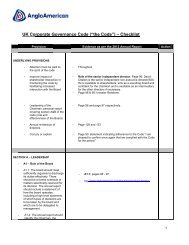Anglo American Annual Report 2012
Anglo American Annual Report 2012
Anglo American Annual Report 2012
- No tags were found...
Create successful ePaper yourself
Turn your PDF publications into a flip-book with our unique Google optimized e-Paper software.
Applicationsthat makeuse of copper’selectricalconductivitymake upapproximately60% of totalglobal demand.BUSINESS OVERVIEWWe have interests in six copperoperations in Chile. The MantosBlancos and Mantoverde mines arewholly owned and we hold a 50.1%interest in <strong>Anglo</strong> <strong>American</strong> Sur(AA Sur), which includes theLos Bronces and El Soldado minesand the Chagres smelter. We alsohave a 44% shareholding in theCollahuasi mine. The mines produce acombination of copper in concentrateand copper cathode together withassociated by-products such asmolybdenum and silver.In addition, we have a controllinginterest in the Quellaveco (81.9%)and Michiquillay (100%) projectsin Peru and a 50% interest in thePebble project in Alaska.INDUSTRY OVERVIEWCopper’s principal use is in the wireand cable markets because of themetal’s electrical conductivity andcorrosion resistance. Applicationsthat make use of copper’s electricalconductivity, such as wire (includingthe wiring used in buildings), cablesand electrical connectors, make upapproximately 60% of total globaldemand. The metal’s corrosionresistantproperties find numerousapplications, particularly plumbing pipeand roof sheeting, in the constructionindustry, which accounts for a further20% of demand. Copper’s thermalconductivity also makes it suitable foruse in heat-transfer applications suchas air conditioning and refrigeration,which constitute some 10% of totaldemand. Other applications includestructural and aesthetic uses.Access to quality orebodies, locatedin regions providing stable political,social and regulatory support forresponsible and sustainable mining,are likely to continue to be the keyfactor distinguishing project returnsand mine profitability. However, suchorebodies are scarce, and it will beincreasingly necessary for miningcompanies to develop mines in morechallenging environments. With nofundamental technological shiftsexpected in the short to medium term,forecast long term demand is likely tobe underpinned by robust growth incopper’s electrical uses, particularlywire and cable in construction,automobiles and electricityinfrastructure. The key growth areawill continue to be the developingworld, led by China and, in the longerterm, India, where early-stageindustrialisation and urbanisationon a large scale continues to propelcopper demand growth. Moreover,the intensity of copper consumptionis still at a high level in the case ofChina, while in India it is on anupward trajectory. This is in contrastwith the advanced economies andtheir much lower levels of intensity.In spite of near term supply growth thatcould well be noticeably above that ofthe past six or seven years, constraintson the supply side are likely to prove astructural feature of the market. Thiswill be driven by continuing declinesin ore grades at maturing existingoperations and new projects, a lackof capital investment and underexplorationin the industry, as well aspolitical and environmental challengesin many current and prospectivecopper areas.The industry is capital-intensiveand is likely to become more soas high grade surface deposits areexhausted and deeper and/or lowergrade deposits are developed in morechallenging locations. Combined withthe need to develop infrastructure innew geographies, this requires greatereconomies of scale if mines are to becommercially viable. Scarcity of waterin some countries, such as Chile andPeru, is also necessitating theconstruction of capital- and energyintensivedesalination plants.During the period 2000–2011, Chinaincreased its share of first-use refinedmetal consumption from 12% to anestimated 39%. Consumptioncontinued to increase in <strong>2012</strong>, whiledemand elsewhere fell in aggregatefor the second year running, movingChina’s share of refined demandabove 40%.OPERATINGWATERMANAGEMENTIN THE ANDESOur Copper business in Chilewas faced with the challenge ofincreased water requirementsin an already water-constrainedenvironment. With significantdemand on water by various localusers, the Los Bronces operationneeded to minimise its use offresh water from the MetropolitanRegion catchment area, home tomore than 7 million people.When expanding Los Bronces,we constructed a waterrecirculation system stretchingfrom the Las Tórtolas tailings damback to the Los Bronces mine.The system returns water,previously used to transport ore,back to the mine, located some3,600 metres above sea level.Water is pumped through apipeline 52.5 kilometres long,with a total elevation differenceof 2.5 kilometres from end to end.At a total cost of $180 million,the decision to opt for a waterrecirculation system went wellbeyond short term economicconsiderations. A feat of worldclass engineering was required– entailing a trade-off betweenhigher energy requirements andcarbon emissions on the onehand and water savings on theother – if the mine was tohave the capability to adaptsuccessfully to current andanticipated future watersupply limitations.The initiative has reduced themine’s water requirement from0.81 to 0.52 million m 3 /tonne,with more than 22 million m 3being recirculated during <strong>2012</strong>.ImageLas Tórtolas tailings dam, close to theLos Bronces copper mine in Chile.Operating and financial review<strong>Anglo</strong> <strong>American</strong> plc <strong>Annual</strong> <strong>Report</strong> <strong>2012</strong> 69



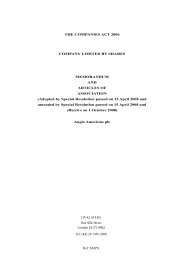
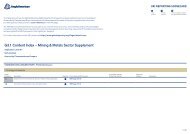
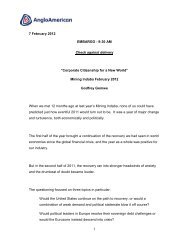
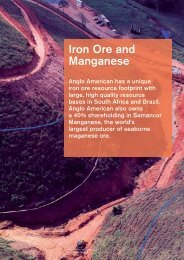
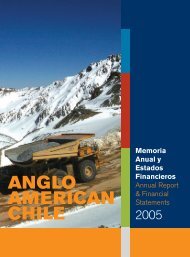
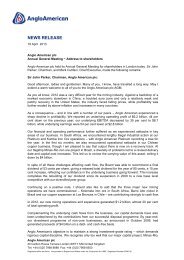
![English PDF [ 189KB ] - Anglo American](https://img.yumpu.com/50470814/1/184x260/english-pdf-189kb-anglo-american.jpg?quality=85)
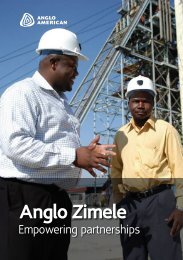

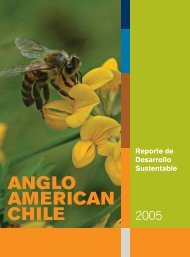
![pdf [ 595KB ] - Anglo American](https://img.yumpu.com/49420483/1/184x260/pdf-595kb-anglo-american.jpg?quality=85)
![pdf [ 1.1MB ] - Anglo American](https://img.yumpu.com/49057963/1/190x240/pdf-11mb-anglo-american.jpg?quality=85)
